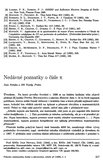Article
Full entry |
 PDF
(2.6 MB)
Feedback
PDF
(2.6 MB)
Feedback
 PDF
(2.6 MB)
Feedback
PDF
(2.6 MB)
Feedback
References:
[1] Adamchik, V., Wagon, S.: $\pi $: A 2000-year-old search changes direction. Mathematica in Education and Research 5 (1996), 11–19 (text článku lze nalézt v elektronické podobě na URL adrese < http://www.wolfram.com/~victor/articles/pi/pi.html>)
[2] Adamchik, V., Wagon, S.: A simple formula for $\pi $. Amer. Math. Monthly 104 (1997), 852–855. MR 1479991 | Zbl 0886.11073
[3] Bailey, D. H.: A polynomial time, numerically stable integer relation algorithm. NAS Technical Report Server (RNR-91-032, December 1991).
[4] Bailey, D. H., Borwein, P. B., Plouffe, S.: On the rapid computation of various polylogarithmic constants. Math. Comp. 66 (1997), 903–913. MR 1415794 | Zbl 0879.11073
[5] Bailey, D. H., Ferguson, H. R. P.: Numerical results on relations between fundamental constants using a new algorithm. Math. Comp. 53 (1989), 649–656 (*). MR 0979934 | Zbl 0687.10002
[6] Bailey, D. H., Plouffe, S.: Recognizing numerical constants. Organic mathematics (Burnaby, BC, 1995), CMS Conf. Proc. 20 (1977), Amer. Math. Soc., Providence, RI, 73–88 (preprint z r. 1995). MR 1483914
[7] Bailey, D. H., Borwein, J. M., Borwein, P. B., Plouffe, S.: The quest for Pi. Math. Intelligencer 19 (1997), no. 1, 50–57. MR 1439159 | Zbl 0878.11002
[8] Beckmann, P.: Historie čísla $\pi $. Academia, Praha 1998 (překlad 5. vydání z r. 1982).
[9] Bellard, F.: < http://www-stud.enst.fr/~bellard/pi-challenge/index.html> a dále < http://www-stud.enst.fr/~bellard/pi-challenge/announce220997.html>
[10] Berggren, L., Borwein, J. M., Borwein, P. B.: $\pi $: A source book. Springer, New York 1997. MR 1467531 | Zbl 0876.11001
[11] Borwein, J. M., Borwein, P. B.: The arithmetic-geometric mean and fast computation of elementary functions. SIAM Rev. 26 (1984), 351–366 (*). MR 0750454 | Zbl 0557.65009
[12] Borwein, J. M., Borwein, P. B.: Pi and the AGM: A study in analytic number theory and computational complexity. John Wiley & Sons, New York 1987. MR 0877728 | Zbl 0611.10001
[13] Borwein, J. M., Borwein, P. B.: Ramanujan and Pi. Science and applications; Supercomputing 88, Vol. II (1988), 112–117 (*).
[14] Borwein, J. M., Borwein, P. B., Dilcher, K.: $\pi $, Euler numbers and asymptotic expansion. Amer. Math. Monthly 96 (1989), 681–687 (*). MR 1019148
[15] Borwein, J. M., Borwein, P. B., Girgensohn, R., Parnes, S.: Making sense of experimental mathematics. Math. Intelligencer 18 (1996), no. 4, 12–18 (preprint s názvem “Experimental mathematics: a discussion” z r. 1995 je k dispozici na serveru CECM, viz [23]). MR 1413248 | Zbl 0874.00027
[16] Borwein, J. M., Borwein, P. B., Bailey, D. H.: Ramanujan, modular equations, and approximations to Pi or How to compute one bilion digits of Pi. Amer. Math. Monthly 96 (1989), 201–219 (*). MR 0991866
[17] Brent, R. P.: Fast multiple-precision evaluation of elementary functions. J. Assoc. Comput. Mach. 23 (1976), 242–251 (*). MR 0395314 | Zbl 0324.65018
[18] Castellanos, D.: The ubiquitous $\pi $. Math. Magazin 61 (1988), 67–98 a 149–163. MR 0934824 | Zbl 0654.10002
[19] Goldstine, H. H.: A history of numerical analysis from the 16th through the 19th century. Springer, New York 1977. MR 0484905 | Zbl 0402.01005
[20] Hančl, J.: Two proofs of transcendency of $\pi $ and e. Czech. Math. Journal 35 (1985), 543–549. MR 0809040
[21] Iwamoto, Y.: A proof that $\pi ^2$ is irrational. J. Osaka Inst. Sci. Tech. 1 (1949), 147–148. MR 0037863
[22] Jarník, V.: Diferenciální počet I. Academia, Praha 1984 (6. vydání).
[23] Kanada, Y.: (lze také nalézt na adrese < http://cecm.sfu.ca/personal/jborwein/Kanada_50b.html>) Zbl 1052.68668
[24] Kořínek, V.: Základy algebry. NČSAV, Praha 1953. MR 0075914
[25] Knopp, K.: Theorie und Anwendungen der unendlichen Reihen. Springer, Berlin 1924. MR 0028430
[26] Niven, I.: A simple proof that $\pi $ is irrational. Bull. Amer. Math. Soc. 53 (1947), 509 (*). MR 0021013 | Zbl 0037.31404
[27] Novák, B.: O sedmém Hilbertově problému. Pokroky MFA 17 (1972), 245–256.
[28] Novák, B.: A remark to a paper of J. F. Koksma. Nieuw Arch. voor Wiskunde 23 (1975), 195–197. MR 0406941
[29] Novák, B.: Vybrané kapitoly z teorie čísel. SPN, Praha 1972.
[30] Plouffe, S.: < http://www.lacim.uqam.ca/ploufe/Simon/results.html> Zbl 1010.11071
[31] Rabinowitz, S. D., Wagon, S.: A spigot algorithm for the digits of $\pi $. Amer. Math. Monthly 103 (1995), 195–203. MR 1317842 | Zbl 0853.11102
[32] Ramanujan, S.: Modular equations and approximations to $\pi $. Quart. J. Math. 45 (1914), 350–372.
[33] Salamin, E.: Computation of $\pi $ using arithmetic-geometric mean. Math. Comp. 30 (1976), 565–570 (*). MR 0404124 | Zbl 0345.10003
[34] Taylor, S. J.: Pravidelnost náhodnosti. Pokroky MFA 25 (1980), 28–34 (překlad).
[35] Veselý, J.: $\pi $ aneb 3,14159.. Učitel matematiky 3 (15), 4 (16) (1995), 1–10 a 1–13.
[36] Veselý, J.: Matematická analýza pro učitele. Matfyzpress, vydavatelství MFF UK, Praha 1997.
[37] Wagon, S.: Is Pi normal?. Math. Inteligencer 7 (1985), no. 3, 65–67 (*). MR 0795541 | Zbl 0565.10002
[38] Williams, R.: < http://www.ccsf.caltech.edu/~roy/pi.formulas.html> Zbl 1200.57005
[39] Borwein, J. M.: Brouwer-Heyting sequence converge. Math. Intelligencer 20 (1998), no. 1, 14–15. MR 1601815

